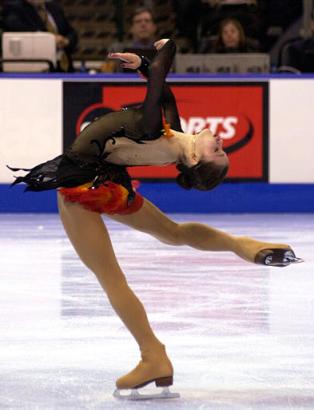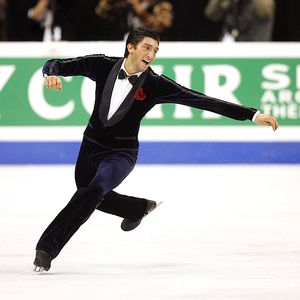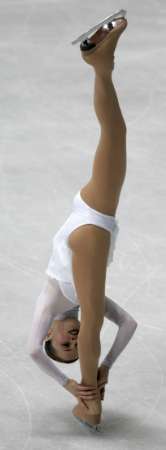
The reason core strength and leg strength are important for any sport, specifically skating, is because most movements and balance depend on your leg muscles and your core strength. If your core and your leg muscles are weak, it becomes extremely difficult to achieve any skating skills. Good balance not only keeps you steady on your feet, but it helps make your movements powerful. Having a strong core and good leg strength mean better performance in different sports.
En route to a strong body, keep in mind that the body needs fuel. Your nutrition, as well as your training, is equally as important. Make sure you have the right amount of protein necessary for optimal training. Keep your fat intake low. Under no circumstances should you give up your carbs. You need complex carbohydrates. It is what fuel you while you are working out. Eat whole grains, vegetables, and fruits.
The core is the center of your body's strength, your "powerhouse" and the foundation for all of your movements. Your legs’ muscles are equally as important in maintaining your balance. They are those muscles that lift your leg to the side, your toes, and they keep you moving forward. It is important to keep those muscle groups strong. The primary abductor that lifts the leg to the side is the gluteus medius; this muscle is of extreme importance to skaters. As you strengthen your core and your leg muscles, balance can be improved. The muscles that comprise the core, pelvis and hips, must be strong in order to work efficiently.
To develop core strength you need to work the muscles of the core. This requires you to do a lot more than your traditional crunches. You can perform moves such as: the
Plank exercises which requires that you lay face down on a mat resting on the forearms, with palms flat on the floor. As you push off the floor, raising up onto toes and resting on the elbows. Make sure you keep your back flat, in a straight line from head to heels. Tilt your pelvis and contract your abdominal muscles to prevent your rear from sticking up in the air. Hold the position for at lest for 20 to 60 seconds, lower and repeat for 3-5 reps.The plank exercise is a great way to build endurance in both the abs and the back. It helps to stabilize the muscles as well. For the
bridge exercise, lie on your back with your knees bent. Keep your back in a neutral position, not arched and not pressed into the floor. Tighten your abdominal muscles as you raise your hips off the floor until your hips are aligned with your knees and shoulders. Hold for three deep breaths. Another good exercise for the core is the
Russian twist. This is done by sitting on the ground and place your feet under a stable surface. With your knees bent, slightly lean back while keeping your torso straight. With one hand on the other, and arms straight, move your arms from one side to another. Do not pause in the middle. Make sure you breathe properly; do not hold your breath. You can perform this exercise with a weight for a more intense exercise.The
Supperman exercise is good to help strengthen your lower back, and it is good helpful way to enhance your balance. While keeping one arm and one leg on the floor, lengthen the opposite arm and leg to a full extension. Contract the muscles in the lower back and buttocks. The great benefit of having good core strength is the fact that you don't have to worry about issues dealing with your back or hip muscles which can lead to other injuries. The possibilities of you missing ice time will be minimized. Core strength can be improved by working on the center of your body. The core exercises help. You strengthen your core muscles. Any exercise that uses the trunk of your body without support helps.
The lower body contains some of your biggest muscles groups which are capable of bearing significant weight. Having good balance means having strong leg muscles as well. The most important muscles in the lower body for good balance are your hips and quadriceps. Exercises for these muscles include
Hip Abduction. To strengthen the front of your legs you can do
leg press exercises,
straight leg raises and
Knee extensions.
Hip Abduction: This exercise strengthens the muscles of the outer, upper leg. This exercise is for inner thighs. This is done in a standing posture. Do it with keeping the hip straight and moving the thigh inwards toward the midline of the body. This exercise works the largest hip muscle and inner thigh.
Leg press: Use your abdominal muscles to raise your feet in an arc to a position directly above your head. Repeat until the desired number of repetitions is complete. This is a useful exercise for the quads but it also works the hamstrings and glutes.
Straight leg raises: Contract the quadriceps muscles at the front of the thigh. Hold for 10 seconds. Relax and rest for three seconds.
Knee extensions: Sit in a chair, with your back resting against the back of the chair. If your feet are flat on the floor in this position, you should place a rolled-up towel under your knees to lift them up. Only the balls of your feet and your toes should be resting on the floor. Rest your hands on your thighs or on the sides of the chair. Take three seconds to extend your right leg in front of you, parallel to the floor, until your knee is straight.
With your right leg in this position, flex your foot so that your toes are pointing toward your head; hold your foot in this position for at least three seconds. Take five seconds to lower your right leg back to the starting position, so that the ball of your foot rests on the floor again. Repeat with left leg. Alternate legs, until you have done the exercise 10 to 15 times with each leg.
Squat is the best exercise, for leg strength. Stand with feet shoulder-width apart, toes pointed slightly out, holding dumbbells or a barbell behind your neck and across your shoulders. Keeping your head up, back straight and feet in full contact with the floor, bend at the hips and move your butt backward until your thighs are parallel to the floor. Don't allow your knees to extend in front of your toes. As you Maintain that posture, bring your hips forward as you return to a standing position.
Lunge: Holding dumbbells on your shoulders, stand with your feet shoulder-width apart. Keep your head up and back straight, bring one leg forward and bend at the knee until your front leg forms a 90-degree angle and the knee of your back leg almost touches the floor. Return to the upright position and alternate legs. Again, keep proper form and don't allow the front knee to pass in front of the toes. Try to maintain a long stride for better results.
Deadlift focuses on the whole posterior chain. Feet should be placed at armpit width with toes slightly out. Shins will be placed next to the bar. The majority of the body weight should begin on the balls of the feet with a transfer to the heels through lockout. The hands should grasp the bar with an over / under grip with the arms outside the knees. The legs should be bent to approximately 60 degrees from vertical with the hips lower than the shoulders. Your head should be looking forward in a neutral position. The chest should be forward, not down. Shoulders should be squeezed tightly back and positioned directly over the bar. Do not round the shoulders, as more force will then be applied to the back. Stand behind the bar, so that it is over the balls of your feet. Keep your feet shoulder width apart, pointing forwards or slightly outwards. Squat down and grasp the bar, hands slightly greater than shoulder width apart. Thighs should be approximately parallel to the ground, back straight, and eyes looking forward. Keeping the back rigid and arms straight, lift the bar using the legs, keeping the bar as close to the body as possible.
Balance exercises help you maintain strong core and leg muscles and prevent falls. The leg consists of multiple parts. The Quadriceps are the muscle group in the front of your thigh above the knee which is used to extend the knee, the hamstrings are a group of muscles in the back of your thigh, they do the opposite and flex or retract your knee. The calves are the group of muscles that are located on the lower leg in the back opposite side of the shin. They are used to extend your ankle or raise your heel if you are standing. All the leg muscles work together to create speed and movement. They work in conjunction with each other, for power, acceleration and speed. Every muscle is important. Do not just train one muscle group, train them all. Strong leg muscles, especially in the quadriceps, hamstring area, and calves, are essential in figure skating. Much of your power comes from your legs, and staying balance requires strong leg muscles as well.
If you want to increase your core and leg strength for better balance, your quads, hamstrings and abdominal are the muscles to concentrate on. Exercises such as the Russian Twist and sit-ups and crunches are good."The Plank" help[s strength the core; try to hold it for around 30 seconds at a time and increase as you get stronger. Things like leg raises also help. Keep in mind, maintaining a diet rich in protein and low in fat is important in any workout routine to enhance muscle growth and development, or you will get absolutely nowhere. Concentrate on overall fitness and maintaining a healthy regime.
Nothing beats healthy eating. Eat a combination of lean protein and complex carbohydrates. Spread your meals. Your metabolism is a machine continuously at work. It needs fuel. Eat smaller meals every few hours throughout the day to accelerate fat loss and to maintain stable energy levels. For best results, eat six smaller meals a day. Eat your protein, lean chicken, fish, egg-whites and beans. Consume as much fruits and vegetables. Drink at least three quarts of water per day. SODA is your worst enemy, diet or not. As you do your reps, concentrate on total body strength with emphasis on core and leg strength.












